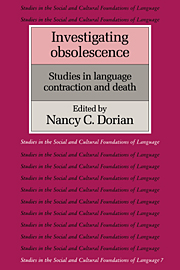Book contents
- Frontmatter
- Contents
- List of maps
- List of contributors
- Preface
- Map
- Dedication
- Introduction
- I Focus on context
- II Focus on structure
- 11 Problems in obsolescence research: The Gros Ventres of Montana
- 12 The structural consequences of language death
- 13 On signs of health and death
- 14 Case usage among the Pennsylvania German sectarians and nonsectarians
- 15 Estonian among immigrants in Sweden
- 16 The incipient obsolescence of polysynthesis: Cayuga in Ontario and Oklahoma
- 17 Urban and non-urban Egyptian Nubian: Is there a reduction in language skill?
- 18 Some lexical and morphological changes in Warlpiri
- 19 Language contraction and linguistic change: The case of Welland French
- 20 Lexical innovation and loss: The use and value of restricted Hungarian
- III Invited commentaries
- Bibliography
- Index of languages
- General index
11 - Problems in obsolescence research: The Gros Ventres of Montana
Published online by Cambridge University Press: 08 January 2010
- Frontmatter
- Contents
- List of maps
- List of contributors
- Preface
- Map
- Dedication
- Introduction
- I Focus on context
- II Focus on structure
- 11 Problems in obsolescence research: The Gros Ventres of Montana
- 12 The structural consequences of language death
- 13 On signs of health and death
- 14 Case usage among the Pennsylvania German sectarians and nonsectarians
- 15 Estonian among immigrants in Sweden
- 16 The incipient obsolescence of polysynthesis: Cayuga in Ontario and Oklahoma
- 17 Urban and non-urban Egyptian Nubian: Is there a reduction in language skill?
- 18 Some lexical and morphological changes in Warlpiri
- 19 Language contraction and linguistic change: The case of Welland French
- 20 Lexical innovation and loss: The use and value of restricted Hungarian
- III Invited commentaries
- Bibliography
- Index of languages
- General index
Summary
Linguistic researchers who find themselves working with severely contracting speaker groups may begin with entirely different interests and objectives, yet very likely soon find themselves confronted by intriguing linguistic and sociolinguistic phenomena which turn up in the process of their investigations.
In theory, if the group is of sufficient size at the start of the investigation and the contraction of the linguistic community is gradual, there may be time and evidence enough to identify some of the phenomena early on and to observe their development. If the group is already small, its membership not entirely clearcut, and its further contraction rapid, then the researcher's observations are likely to be more tantalizing and suggestive than full and conclusive, and the fieldwork and research problems will be compounded. The latter is the case with many diminishing Native American languages, including the one reported on here.
In this chapter I will describe several different sociolinguistic and structural aspects of Gros Ventre obsolescence. In passing, I will also refer to various problems which had to be confronted in the course of the research.
What I know about Gros Ventre obsolescence has been discovered largely by accident, and comes from random aberrant forms which have turned up in my fieldnotes, from remarks made by my informants about the speech of others, and from my own observations of life and personal relations on the reservation. I must admit, however, that some of what I claim rests on rather slim evidence, and may prove eventually to be erroneous or better explained in other ways.
- Type
- Chapter
- Information
- Investigating ObsolescenceStudies in Language Contraction and Death, pp. 167 - 180Publisher: Cambridge University PressPrint publication year: 1989
- 4
- Cited by

